3 Companies Working to Demystify Healthcare
I’m going to be candid and call out my privilege and my millennialism. I recently turned 26, which in California meant that the health insurance I have been using my whole life under my father’s company ended. I’m fortunate to work for a company that provides health insurance, so I figured the transition would be no big deal.
Turns out, I was to be greeted by a resounding chorus of: “Surprise again, adulthood sucks!” Figuring out my new plan was basically like doing a 2,000-piece puzzle of the night sky.
Finding new doctors, dentists and hospitals was frustrating to say the least. One day I played a rousing game of telephone pinball where I was flung back and forth between the HR company, the insurance provider and the medical office — all to get in one silly routine doctor appointment.
Confusion over health insurance is ubiquitous. No matter how you feel about healthcare in our country, I think one thing can be agreed upon: it needs to catch up with technology.
That’s why we are seeing B2C companies attempt to disrupt not just categories, but industries. Companies are trying to facilitate an easier option than telephone pinball.
Challenging the status quo through marketing
Nurx, Talkspace and Quip are all excellent examples of pinball detractors.
Research into the marketing of these three companies reveals a clear, common strategy: to challenge and critique the current industry status quo and prove that technology can make health services simpler and more accessible.
Here’s a peek at how each of these companies does this.
Nurx brings birth control to your door
To use Nurx’s birth control delivery service, all someone has to do is enter their information on the Nurx site. Depending on the user’s insurance, Nurx will mail you a prescription for free or typically for about $15 without insurance.
Nurx’s tagline is literally ‘Healthcare Reimagined,’ and it’s present throughout their marketing.
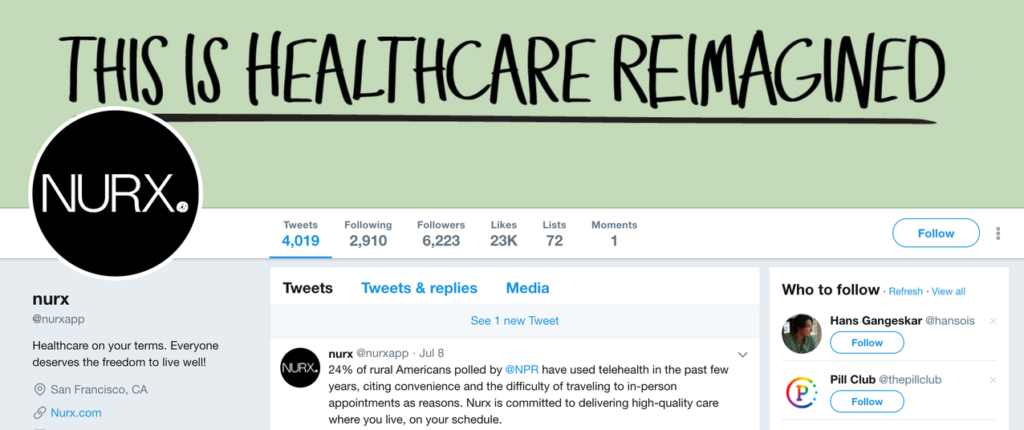
Birth control can be difficult to access, especially in more rural parts of the country. Research has shown that nearly 20 million women live in zones nicknamed ‘contraceptive deserts,’ or locations that lack reasonable care for women’s services.
Nurx reimagines a healthcare system that anyone has access to. Here is a recent commercial by the company showing how ordering birth control through them is effortless.
In the video, we are first made to believe a young woman is at a doctor’s office, but skillful camera work reveals her to actually be at home multitasking and interacting with a doctor via the Nurx app. This clever scene highlights the convenience avoiding a time-consuming visit to the doctor.
Other types of content as seen on their Twitter feed include research articles on healthcare, advice from professionals, and demystifications around women’s reproductive health.
Talkspace destigmatizes therapy
Talkspace is an app that allows anyone to chat with a licensed therapist. Their marketing focuses on eliminating the excuse that life is too busy to go to therapy, as well as eliminating the stigma around mental health care.
One in five adults (46.6 million) experience some form of mental illness in the course of a year, and suicide is the second cause of death for people aged 10-34. Alarming stats like these are the reason that mental health awareness has increased over the past few years, but we still have a ways to go.
Talkspace’s marketing emphasizes the importance of taking care of one’s mental health. They do this by sharing testimonials (like this one from Michael Phelps) and also teaching about different mental health issues that exist (like this one on high functioning anxiety).
They’ve filled their blog with helpful content that’s aimed at educating people about positive mental health practices.
Aside from their educational content, Talkspace emphasizes similar rhetoric to Nurx’s philosophy. Here’s a short intro video on their YouTube that highlights the convenience and simplicity of the app while evangelizing their philosophy on accessible mental healthcare.
They believe that therapy should be available, affordable, stigma-free and anonymous. Companies like Nurx and Talkspace envision healthcare for all in the comfort of their own home, which is a pretty huge contrast to the healthcare institution as it exists.
Quip strives for more transparency in dental work
Quip‘s toothbrush naturally placed them in the healthcare space when they started, but they recently expanded their product to include their own dental insurance.
Most will recognize them as the social media-friendly toothbrush company that has dominated the likes of podcasts and Facebook ads in the last year, but this week they announced they would also be disrupting the dental insurance industry with the launch of quipcare, in hopes to make preventative oral care easier for people.
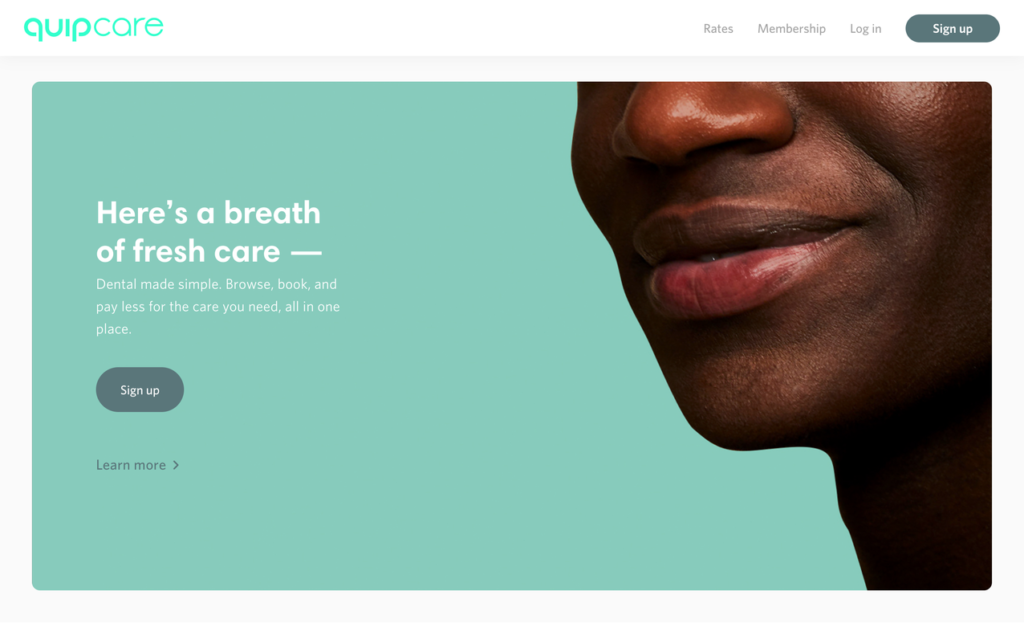
Quip recognizes that 40% of people don’t visit the dentist once a year, even when insured. They aim to decrease this statistic with quipcare.
I’ve seen the same family dentist my whole life and they still do almost everything manually. Quip has built an all-in-one app where you can schedule your appointments, see rates ahead of time, and even get rewarded for completing visits.
Because the app is hot off the press, their consumer product still dominates their marketing, but I imagine we will be seeing some pretty neat posts coming from the company in the coming months.
B2C healthcare brings a new wave of transparency
Companies like Nurx, Talkspace and Quip aren’t just supporting a cause in their marketing. The products themselves exist for a cause and their marketing supports the product.
Healthcare is complicated to navigate and confusing for most people, but especially for people without insurance and who are just becoming responsible for their own insurance. Brands like these help significantly with some of the most mundane tasks that can require so much back and forth going through traditional channels.
I hope the state of healthcare improves at some point, but in the meantime, I don’t mind companies like these stepping in and making the process as painless as possible.
Gillette’s Inclusive Masculinity
We wrote about the controversial Gillette campaign, “The Best a Man Can Be,” a few months back when it premiered. Despite the hoards of consumers taking to social media swearing they would never buy a Gillette product again, the company has stuck with the campaign.
In the past couple of weeks, two new Gillette ads surfaced that might explain why. Much like the first ad of the campaign, these ads attempt to broaden traditional notions of masculinity, reshaping and reimagining what the word means today.
A Man’s First Shave
In the first ad, which debuted on their Facebook page, Gillette looks beyond biological maleness and features a trans man’s first shave with his father.
Trans voices are so often left out of product advertisements, especially if the product is associated with gender. We don’t see bra commercials featuring trans bodies either. And yet these bodies exist! Gillette isn’t taking any political stance here, even though some angry commenters felt like the company was. Gillette’s inclusivity is only demonstrating an understanding that leaving out huge segments of the population alienates many in their consumer base.
Scrolling through the comments reveals hundreds of positive responses, including a heartfelt thank you from Samson, the young man featured in the video.

Capturing a defining moment in the life of a real person authenticates their message about a more inclusive masculinity.
“Real Men” Do All Sorts of Things
The second recently released ad marked an international expansion of this campaign. Gillette Spain released “It Takes a Real Man” or “Hay Que Ser Muy Hombre,” which features five of Spain’s male celebrities, including actors, athletes, and a drag queen.
The short ad shows cheeky moments from these celebrities challenging the viewer to consider whether they have what it takes to be a real man. But they don’t shotgun a beer, lift something heavy, throw a ball fast, or other “real man” stunts. Instead, we see synchronized swimmer Pau Ribes shaving his legs as he asks the viewer, “Are you man enough to swim upstream?” And, photographer/drag queen Rubén Errebeene asks, “Are you man enough to be a queen?”
According to Adweek, this campaign was inspired by a study conducted by Salvetti Llombart and sponsored by Gillette. The study showed that 75% of Spanish men don’t identify with traditional male stereotypes. It received a similar reaction as the first campaign did, with most social media backlash coming from angry men. The study suggests that, while maybe their voices are the loudest, they do not represent popular opinion.
Maybe that’s why Gillette has continued such a controversial campaign.
Lush and Ben & Jerry’s Didn’t Ask You to Buy Your Mom Lotion or Ice Cream for Mother’s Day
This Mother’s Day two brands gave an important shoutout to the National Bail Out Collective (NBO), who for the third year in a row held a national fundraiser to help bail out black mothers on Mother’s Day.
Ben & Jerry’s released a blog post providing statistics and context to the issue at hand, while Lush took to their large social media following on Instagram and Twitter to share a simple bold statement: “Bail out black mamas this Mother’s Day.”
According to research cited in the Ben & Jerry’s blog post, there are 2.3 million mothers incarcerated today, and 1 in 9 black children have a parent in jail versus 1 in 57 white children.
This staggering statistic was enough for two brands, who could have easily centered Mother’s Day on their products, to focus their marketing messaging on something more important.

Lush makes skin and beauty products, and Ben & Jerry’s makes ice cream for crying out loud. These are two brands for whom mothers are their ideal customer. But rather than, say Lush blasting out, “Buy your mom these relaxing bath bombs,” both brands exercised brand activism instead.
To be fair, Lush and Ben & Jerry’s regularly exercise other forms of social responsibility regularly. Ben & Jerry’s is known for taking regular political stances on issues, as seen in their Democracy is in Your Hands campaign, for example. Meanwhile Lush has taken a stand against single use plastic, which is reflected in the packaging for many of their products.
But it’s this kind of marketing that demonstrates a new era of brand messaging sparked by millennials and Gen Z, who are one of the most socially conscious generations ever. The social media posts by Lush and the blog by Ben & Jerry’s aren’t demanding anything in return, and while responses to controversial issues will always be mixed, many consumers appreciate this kind of messaging.
By the way, the result of this fundraiser was incredible. The NBO bailed out over 100 mothers in their largest Mother’s Day bailout efforts to date. The marketing efforts by Ben & Jerry’s and Lush should not overshadow the work done by this organization, but hopefully these posts resulted in donations from consumers who would’ve otherwise been unaware of it.
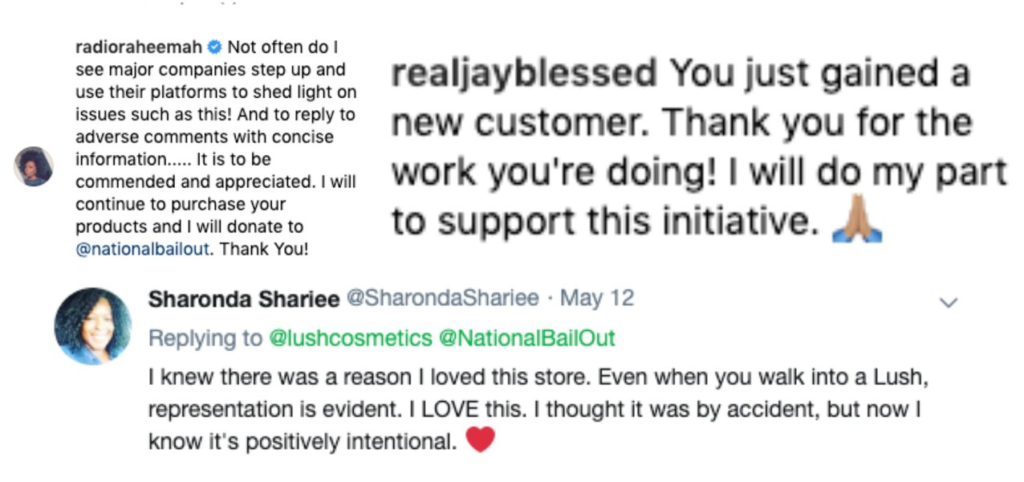
Why these marketing campaigns work in a nutshell:
- They lead to somewhere that isn’t product-related. Both brands include a link to the nonprofit’s site they can donate to directly, making the posts themselves as actionable as possible without focusing on their own product.
- These efforts remind me of the Don’t by This Jacket campaign from Patagonia in that they deflect from the brand’s products, albeit not in the overt way that the Patagonia campaign did. The year they ran this campaign, revenue grew over 30%. By not mentioning product at all, Lush and Ben & Jerry’s might be indirectly attracting sales because of this shift in focus.
To Shave or Not to Shave: Billie Doesn’t Care Either Way
It’s safe to say that hitting marketing firsts these days is tough, but in 2018, one B2C company did just that — and in an industry that’s more than 100 years old.
Billie made its mark as the first body-hair removal company to feature female models with body hair on their underarms and legs.
Billie’s marketing strategy seems obvious since the hair-removal industry relies on the presence of body hair to sell depilatories. But until recently, these companies highlighted the absence of body hair to turn a profit.
Take this Gillette Venus commercial, for example. We see a razor shaving an already-hairless leg.
It’s not like consumer advertising is known for accurately displaying reality, but this specific situation is a bit absurd when you think about it: The success of the hair-removal industry requires the very thing they work so hard to hide.
The history of female hair removal is much longer and more nuanced than the role it has played in U.S. consumerism. Nevertheless, its relationship with advertising has remained uniform. In 1915, Gillette created the first female razor, the Milady Décolleté, when consumer advertising started to take off on a mass scale.
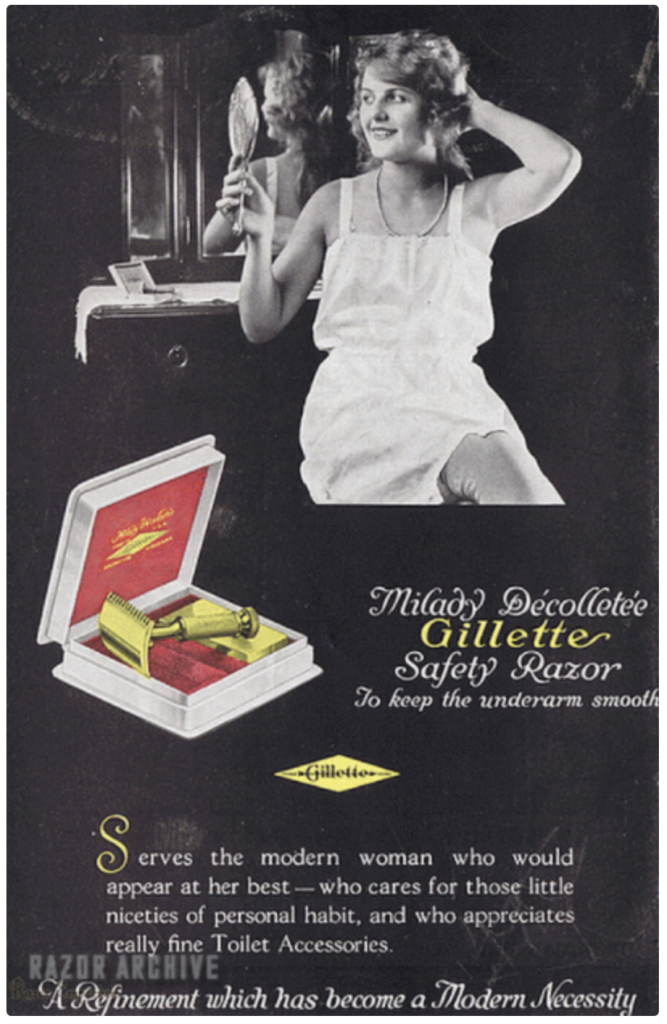
Think about it: The industry is so obsessed with the erasure of a very basic human condition that they refuse to acknowledge its presence in order to sell its disappearance.
Billie has revolutionized razor marketing with its Project Body Hair campaign, which mostly takes place on Instagram and Facebook. Finally, the presence of female body hair is spotlighted.

Billie has also reframed the messaging of hair-removal ads targeting females. Corporations like Gillette focus so much on hairlessness that anything else becomes abnormal and even grotesque. But Billie advocates that women do whatever they want when it comes to their own body hair:
For the past 100 years, women’s razor brands haven’t acknowledged female body hair. Commercials show women “shaving” perfectly smooth, airbrushed legs. Strange, huh? But everyone has short stubble, long strands, or something in between. What you do with yours is up to you – grow it, get rid of it, or comb it. It’s your hair, after all.
Choice is the key differentiator here. This powerful change in rhetoric places more agency in the hands (and on the legs, underarms, and other body areas) of consumers.
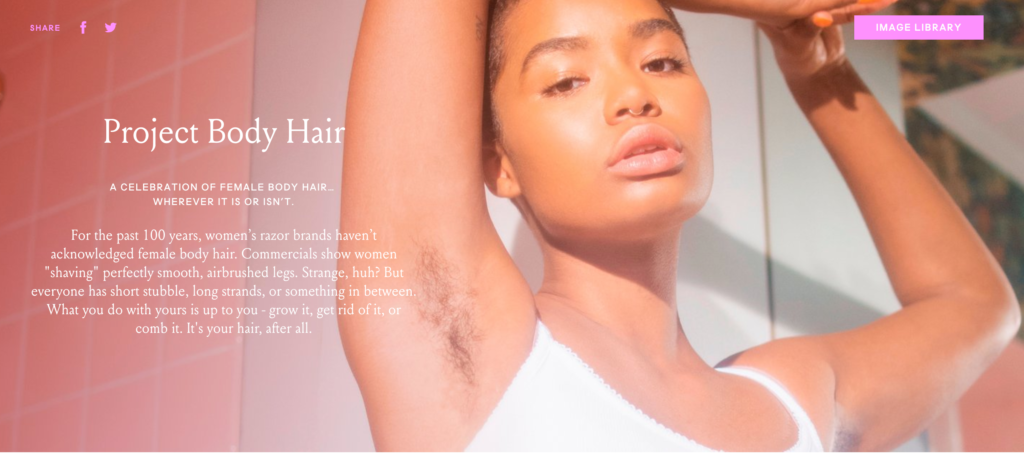
Why the ads work, in a nutshell:
- They aren’t preachy. Billie is careful not to tell customers what to do with their product. Instead, they encourage customers to use their product — or not.
- Many of their ads feature the company’s public rejection of the pink tax. The term was dubbed so when a study found that 42% of the time, women’s items are upcharged by an average of 7% compared to the same exact items for men. Taking a public stance against this blatantly sexist phenomena is wise and also cleverly reveals that women don’t need to pay as much as they have been for razors. Packs of 5 razor heads can go for $16 or more, but with Billie you pay $9 for the same amount of blades.
- The simple choice to show underarm hair and leg hair in its natural state on women’s bodies gives this brand so much more authenticity than their corporate hairlessness-crazed counterparts. The hair is less an object of shame, and more a symbol of empowerment.
- The images on Billie’s social media fit the millennial influencer aesthetic. They are high-quality, interesting, and they position the brand to be a key social media influencer in an industry that has been out of touch with their core consumer base for too long.
Featured image from Billie’s Instagram page
Allbirds’ newest campaign has a nice wing to it
So far, most of the posts in this series have centered around a different socially responsible marketing campaign. The issues exposed in each have been pretty mainstream — like feminism, equality, toxic masculinity, and ethical meat consumption.
The campaign for this week, while centered on a broader topic that most people are aware of (environmentalism), narrows the focus to one specific issue — one that most people might learn about for the first time when they see this ad.
Campaigns like Nike’s latest piggyback on the feminist movement already have an audience. The brands behind campaigns like these hope that the ads will help them earn the support of folks who back the cause. That’s why so many articles about the inherent rift between activism and Capitalism have popped up recently. And with Earth Day coming up, we can expect brands to jump on environmental issues in their marketing.
Allbirds took this to new heights — literally, the subject of the campaign flies every day. Announced in the New York Times and in partnership with the National Audubon Society, Allbirds is rolling out five shoes that correspond to five different threatened North American bird species.
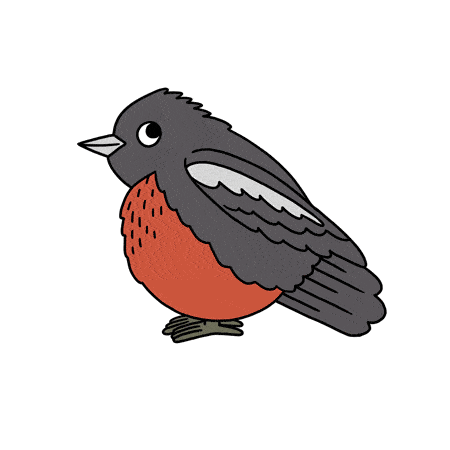
Source
The NYT Brand Studio published a beautiful page for this release, in which the focus is truly on these birds and the issue at hand. The Allbirds name doesn’t even make an appearance in the copy until the very bottom, which is a considerable scroll-down.
In the paragraphs before they mention the shoes, Allbirds suggests taking advantage of the Audubon app and advises readers to learn how they can help the birds in their local ecosystem. By the time readers see their message about corporate responsibility, it’s hard to feel cynical about their intentions.
Now more than ever, it’s important for brands to make things that have a positive impact on the world. Companies have the ability to protect the environment on a larger scale, making the world a more comfortable place for birds and humans alike.
The choice to launch the campaign on the NYT’s site at the top of this week is clever. The campaign will reach a broader audience than if they launched on their own website. It also denotes a more sophisticated and educational understanding of the cause and their partnership.
This campaign is already looking successful. One color of the men’s shoe has completely sold out, as have several sizes on the women’s page.

Allbirds took a different approach with their latest ad. In highlighting an issue that isn’t #trending, and pledging the proceeds to the cause, they take ethical consumerism to a new level.
Why this ad works, in an eggshell:
- It’s a multisensory experience. Click the audio button and the sweet, soothing sound of birds in the wild enter into the reader’s eardrums. Even better, as you scroll down and read about the different birds, the chirping changes to reflect the little hero on the page. It really feels like you are forming an emotional connection with the little creatures when you hear them individually.
- The visuals on this page sway ever so slightly. If the reader has already opted in for the bird sounds, then the effect works to create an even more soothing visual experience. Plus, the reader doesn’t have to feel overwhelmed by more complicated visual imagery, such as video. The most important part of this page is the information in the copy.
- And speaking of copy, Allbirds and the Audubon Society do an excellent job of educating the reader. They go from the broader implications of endangered birds, to the unique stories of each bird, to concrete statistics. For instance: “The Scarlet Tanager is predicted to lose 94 percent of its summer range.” The statistics drive the issue home.
Hero image from Allbirds.
Burger King Meats The Impossible Burger
“Burger King is making an entirely meatless whopper! … April Fools!” Is how you would expect this statement to end, especially since the announcement was aptly made on April Fools Day.
April Fool's jokes are bad. The Impossible™ Whopper® at @BurgerKing is not. https://t.co/GShKUUJSCM
— Impossible Foods (@ImpossibleFoods) April 1, 2019
But no. The impossible is looking quite possible as Burger King begins testing the Impossible Whopper in St. Louis this week — quite possibly the most exciting news, for some, in fast food history.
Burger King has partnered with Impossible Foods to bring a completely plant-based alternative to the BK signature Whopper.
https://twitter.com/BurgerKing/status/1112815237785444352
A quick search of the Twitter Hashtag #ImpossibleWhopper reveals a general sense of support, something that is difficult for any corporate initiative or marketing campaign to achieve on social media.
Red meat consumption has actually been in decline since the 1970s. Since then, both health concerns and the meat industry’s effect on the environment have led to immense changes in public perceptions of meat substitutes. In fact, sales of plant-based meat substitutes increased by 22% to $1.5 billion last year.
BK already offers a MorningStar Veggie Burger, which does not taste like a meat burger. Startups like Impossible Foods are trying to replicate the flavors and textures of meat as closely as possible in hopes that more non-vegetarian consumers will opt for a meat alternative.

Try it and don’t taste the difference. Source
BK surely recognizes the challenge that lays before them in rolling out a meat substitute for their most infamous burger, which is why a localized release is necessary. But making a public splash now only ramps up national anticipation and this period of waiting might even help some overcome their mental meat hurdle to try the literal and figurative Impossible.
The Impossible Whopper is available in the St. Louis area for now. It’s safe to bet that if it’s successful, we will be seeing more from Burger King. However, to mark the introduction, BK released a short commercial featuring real Whopper fans commenting on the taste of the Impossible Whopper vs. the original.
Why this ad works in a nutshell:
- In this campaign, Burger King dares their customers to try something new on the grounds that they won’t even notice the difference. That’s an intriguing bet as a customer. It would be even more exciting to see the money-back guarantee that so many startups like Casper and MeUndies employ out of sheer confidence in their product.
- While there’s nothing new about the “These are real people, not actors” commercial model, Burger King has the perfect opportunity to use it. It’s safe to say that meat, and beef in particular, is ingrained in many Americans’ identities. We all have “that uncle” who fiercely defends his carnivorous tendencies, even when unprompted. Showcasing average Americans who hold the Whopper near and dear to their hearts can help relieve some skepticism for those less familiar with meat substitutes.
- There’s zero ambiguity (and zero cholesterol, btw) on the part of the testers. “This is a f***ing cow!” exclaims one. The surprise that most of these participants feel alleviates doubt and essentially heightens the viewers’ curiosity. Pretty soon, everyone is going to want to see for themselves how the Impossible Whopper doesn’t taste different at all. Everyone that is, except maybe that stubborn uncle.
Intercom’s International Women’s Day Microsite
Many brands tweeted their own take on International Women’s Day last week, but one company took it further by celebrating their female employees in an unusual, fun and creative way.
Intercom published a blog post with a brief statement about the day’s origin and what the day means to them. But a custom-made microsite for the day told the bigger story and showed potential consumers and employees alike that Intercom practices the equality they preach.
Intercom’s International Women’s Day branding strategy is a welcome deviation from the approach taken by most companies. Brands touting their support for women via cheesy ads or one-off social media posts come off as self-congratulatory. A New York Times op-ed on Brawny’s tactic captures this hilariously:
It’s not just your ovaries that we’re celebrating. We also love your strength — you can do anything! As paper towel makers, we’re outraged that we’ve long used a muscular man to market to women — the main purchasers of our product. For one whole month, we are switching the muscular man in our paper towel commercials to inspiring, equally strong (but still delicate, feminine-looking) women.
Oof.
Intercom’s approach shows that they support women every single day — that International Women’s Day isn’t the exception, it’s the rule.
Why this is good marketing:
- The microsite is interactive. Visitors have to use their keyboard to navigate and zoom in and out of the site, making the experience more engaging than simply scrolling through a page.
- By announcing the microsite on their blog first, Intercom is actively driving traffic there. Intercom is a content-marketing behemoth, so announcing the microsite on the blog rather than linking to it on social media or in an email alone indicates that it’s important to the company that their users check it out.
- The blog post and the microsite are incredibly informational. Visitors get to see Intercom’s initiatives around an important issue. The combination of a blog post and a microsite gives Intercom the space to showcase a multifaceted pledge of support. From hosting events to sharing history to vocalizing their support for Balance for Better, Intercom’s efforts are sincere and inspiring.
Nike (and more importantly Serena Williams)
Nike’s “Dream Crazier” Campaign
Aptly titled for its subject matter, “Dream Crazier” is Nike’s newest marketing campaign. Unlike its title, the ad’s focus on female empowerment doesn’t seem like a crazy choice for Nike to make. According to a report from Edelman, 64% of consumers are driven by their beliefs when purchasing. As a result, brands continue to take a stand on cultural and social issues in their marketing, making ads like this less surprising.
Arguably, elevating women is a less contentious social issue today than say the messaging in Gillette’s “The Best Men Can Be” ad on toxic masculinity and even Nike’s own “Dream Crazy” campaign featuring Colin Kaepernick.
However, Nike’s messaging still subverts a dominant narrative about women in sports by emphasizing that gender does not impede female athletes’ abilities to dominate. The rhetoric here is relevant and powerful, considering the status of professional sports:
- Forbe’s Top 100 Highest-Paid Athletes list featured zero women for 2018.
- The NBA earns 100x as much as the WNBA from their deal with ESPN, and ESPN devotes as little as 2% of airtime to women’s sports.
- In 2017, a year after the U.S. women’s soccer team began their fight for equal pay where many players made as little as 40% of what their male counterparts earned, the women’s team received a substantial pay raise (but still not equal pay) and settled the disagreement.
The stats go on, but here is where Nike’s branding fits in. Tropes that follow the reductive and patronizing “run/throw like a girl” rhetoric feed major sports networks’ and team owners’ perceptions of who deserves more airtime and more pay.
Nike aims to challenge this assumption and inspire dreams in the current and next generation of female (and more broadly non-able-bodied male) athletes. They do this by having one of the best athletes in history, Serena Williams, narrate the ad, as well as by featuring several prominent female athletes including Sarah Reinertsen, Caster Semenya, and Tatyana McFadden.
The packaging of this ad is nothing new. As author Joshua Hunt previously wrote about the “Dream Crazy” campaign, “Colin Kaepernick has a dream, and selling dreams is Nike’s business.” Nike is selling the dreams of females everywhere.
Ironically, this progressive stance has garnered backlash. Nike’s problematic labor practices have often overshadowed their efforts at appearing socially conscious. Until Nike demonstrates a powerful and public commitment to advancing the rights of their laborers, consumers are stuck with a collection of marketing campaigns that inspire both equality in sports and ethical dilemmas.
https://www.youtube.com/watch?time_continue=90&v=whpJ19RJ4JY
Why this campaign works in a nutshell, each of which is honestly deserving of their own post:
- It features a host of female powerhouses who deserve recognition. They also pool from an incredibly diverse group, spanning niche sports, different races, and able-ness. Athletes include Simone Biles, an Olympic gold medal gymnast; Chloe Kim, an Olympic gold medal snowboarder; Caster Semenya, a South African 800-meter runner who has faced scrutiny for her naturally high levels of testosterone; Tatyana McFadden, a Paralympian wheelchair racer.
- They call out a timeless (a shoulda, woulda, could-be anachronistic) double standard. While the word crazy was chosen for their previous campaign, it holds more weight here because of its close association with gendered stereotypes. When women show emotion — e.g., cry, express anger, or get competitive — they’ve been called crazy, hysterical, too emotional, or too domineering. This ad reclaims crazy as more than just a sexist remark and turns it into something that women can and should own. Crazy becomes doing something powerful and unbelievable.
- Nike showcases that they are a challenger brand, which helps them stay interesting. As Jeff Brooks, CMO of Casper, notes, “A lot of challenger brands often spend time thinking about who or what they’re fighting against and not necessarily who or what they’re fighting for.” Nike is positioning themselves as a brand that wants to stay culturally relevant, which, as we mentioned above, is becoming more and more important to consumers.
Domino’s Free Pizza Game
Usually, when brands take any sort of altruistic angle in their marketing, people will still argue that it might be in their economic interest to do so, making their public support of a charity or social issue appear less genuine and more exploitative.
Domino’s most recent campaign gives pause to more cynical consumer responses because the campaign doesn’t celebrate Domino’s; it celebrates pizza.
Domino’s opened their Points for Pies campaign the day before the Super Bowl, one of Domino’s most successful days of the year, with a pretty simple call to action to get behind: snap photos of your pizza — ANY pizza, from artisanal to homemade to competitors to toy pizzas — and Domino’s new AI technology will reward you points that lead to getting a free pizza.
It follows a loyalty program model, but participants don’t have to show their loyalty to get the goods. So what’s the catch?
According to Domino’s VP of Advertising, the goal of the campaign is to attract new customers. Other analysts speculate that the campaign’s aim is to create buzz around the brand as well as get customers stoked on Domino’s regular loyalty program, Piece of the Pie Rewards.
Plus, mobile app usage for fast-casual restaurants has steadily increased. 40% of consumers prefer to order food online, and they spend 26% more online than they do in stores.
Obviously, Domino’s has some monetary goal in mind. Participants do have to download the app and create an account, but it’s hard to tell what the ROI of these efforts will be in the long run. Any way you spin it, earning a free pizza by eating any pizza you want is a hard campaign to poke holes in.
As the top pizza company in the world with over 25,000 locations, Domino’s can get away with a campaign that encourages customers to buy their competitors’ product. Heck, the CEO even shot the ad in a competitor’s restaurant. But it may just be this laissez-faire, top-dog attitude that gets them in trouble with customers, especially on social media.
Take a look at the #pointsforpies Twitter feed, for example. Many of the most recent comments, some reporting issues with the app not working, have not seen a response by Domino’s. When you are the proclaimed pizza giant, maybe you can get away with that. Maybe they’ll even attract more customers and increase their loyalty program usage regardless.
Why the campaign works in a nutshell:
- Gamification is an incredibly effective strategy. Gamification has been shown to boost engagement by 47%. As participants level up, they experience an immediate sense of gratification, making it more likely they will keep playing. And what’s more…
- It doesn’t feel impossible to win. Domino’s offer is so out-of-the-box and generous, and the accompanying list of rules and regulations don’t feel imposing at all. Participants are welcome to post once a week, earn a free pizza up to six times, and can expect their points to expire after six months. Not only have they found a way to gamify pizza, but nearly anyone can play and win.
- It’s unequivocally user-centric. Aside from gaining app downloads and potentially more customer loyalty, this campaign focuses on pizza lovers. Participants don’t have to be a Domino’s customer. By extending their reach to all pizza lovers out there, they created an accessible and inclusive campaign for anyone to participate in.
Gillette Isn’t Doing Anything New
Type: Commercial
Campaign Name: We Believe: The Best that Men Can Be
It would be an understatement to say that the most recent Gillette ad campaign provoked a strong and emotional mixed response from consumers. Scroll Twitter and you’re sure to find comments ranging from consumers swearing they will never buy a Gillette product again, to others praising the company for taking a stand on a social issue.
Both reactions stem from the assumption that Gillette took a major branding pivot with “We Believe: The Best Men Can Be.” But one look at the brand’s marketing history shows that, instead, it’s par for the Gillette course. The commercial is selling razors by centering the brand’s narrative around the modern man.
For the past 115 years, Gillette has monetized images of what it means to be a man. In the early 1900s, when the Navy was both modernizing and expanding, this meant naval men finding the time to shave on a “modern battleship.”
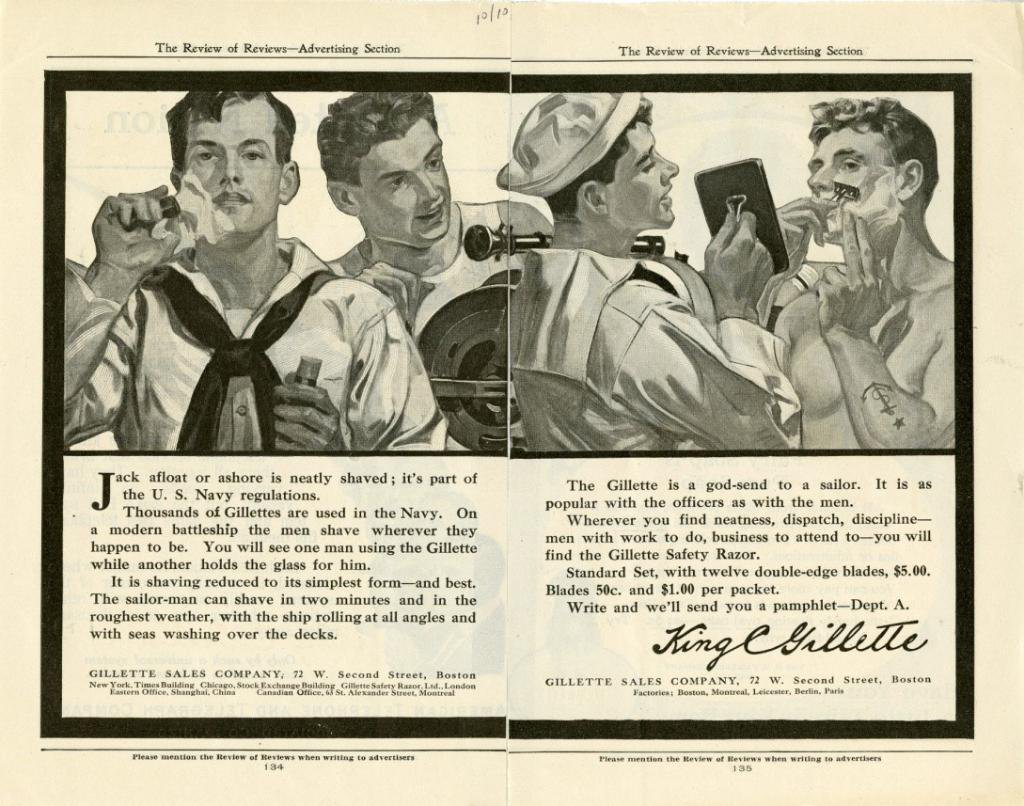
If sailors can shave “on a modern battleship,” then every man should hold himself to that standard. Source
Flash forward to their 1989 campaign, The Best a Man Can Get, which depicted the everyday man in a plethora of heroic tropes — the business executive, the father, the astronaut, the athlete, the husband. Again, it reflected the expectations and tropes of the modern man then.
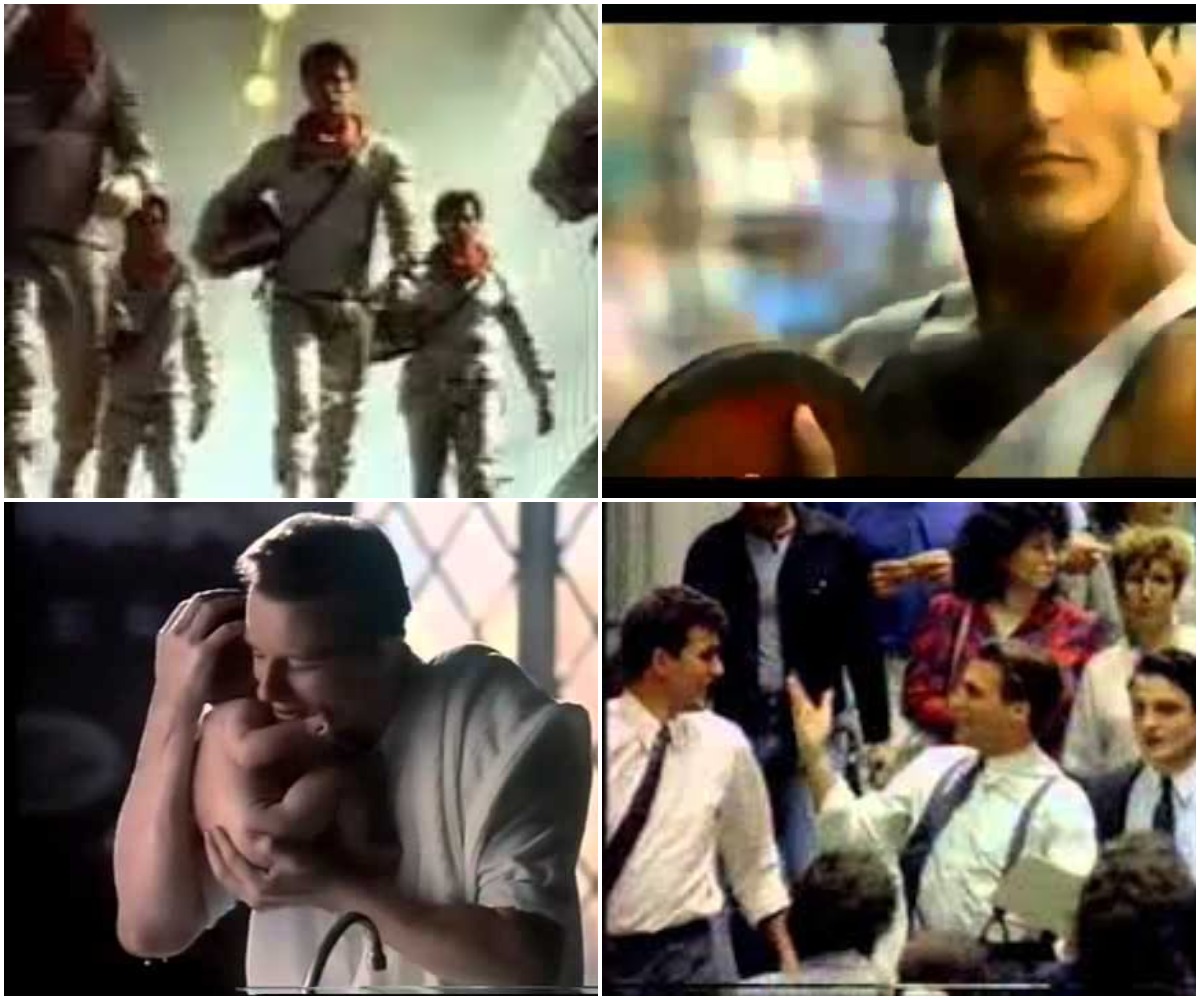
Screenshots from Gillette’s 1989, The Best a Man Can Get ad. Source
Therefore, it’s not surprising that their most recent ad campaign echos a buzzword of 2018: toxic masculinity. Whether you agree with the ad or not, topics around the nuances of masculinity and manhood have been at the forefront of social and cultural discussion, making it a mainstream topic.
Comedian Michael Ian Black writes in the New York Times’ Op-Ed section:
The past 50 years have redefined what it means to be female in America. Girls today are told that they can do anything, be anyone. They’ve absorbed the message: They’re outperforming boys in school at every level. But it isn’t just about performance. To be a girl today is to be the beneficiary of decades of conversation about the complexities of womanhood, its many forms and expressions.
Boys, though, have been left behind. No commensurate movement has emerged to help them navigate toward a full expression of their gender. It’s no longer enough to “be a man” — we no longer even know what that means.
Whereas previous campaigns associated Gillette razors with the “Be a Man” rhetoric, their newest campaign addresses a reevaluation of this notion, a sentiment echoed throughout contemporary social movements. Gillette hasn’t changed its marketing strategy; popular culture has just changed its mind about what the modern man is, and Gillette is reflecting it back to us.
Gillette states, “It’s time we acknowledge that brands, like ours, play a role in influencing culture. And as a company that encourages men to be their best, we have a responsibility to make sure we are promoting positive, attainable, inclusive and healthy versions of what it means to be a man.”
The result of this mission was “We Believe: The Best Men Can Be.”
https://www.youtube.com/watch?v=koPmuEyP3a0
Why the ad works:
- The timing is calculated.
Gillette isn’t the first mainstream brand to challenge toxic masculinity, so why did it garner so much attention? As stated earlier, Gillette has historically reflected the culture’s contemporary perspective on maleness, and it does so again with “We Believe: The Best Men Can Be.” What’s different is the perspective on femaleness that culturally accompanies it. In the era of the #metoo Movement, Gillette provides an overtly male response that says, “We hear you, and we will do better.” Add to that the fact that the spot was released at the top of the New Year — a time when change and self-improvement are at top-of-mind, whether you abide by New Year’s resolutions or not. - It’s self-reflective.
At the heart of the ad is the message that misogyny and toxic masculinity are the result of how men see themselves. Gillette even calls themselves out by harkening back to their own ad 30 years ago at the top of the video. Gillette demonstrates the accountability they are calling for, setting an example for others to follow. - People are talking about it.
For all the backlash the ad campaign received, including a spoof video, there’s no denying that the ad has caused a lot of dialogue. Even negative reactions from some social icons like Joe Rogan, who publicly bashed the campaign on his podcast, indicate that the ad’s message is affecting our culture, which is what Gillette wants in the first place — and of course to sell more razors.
For more marketing campaign analysis and inspiration, sign up for our GetDolphins newsletter here.